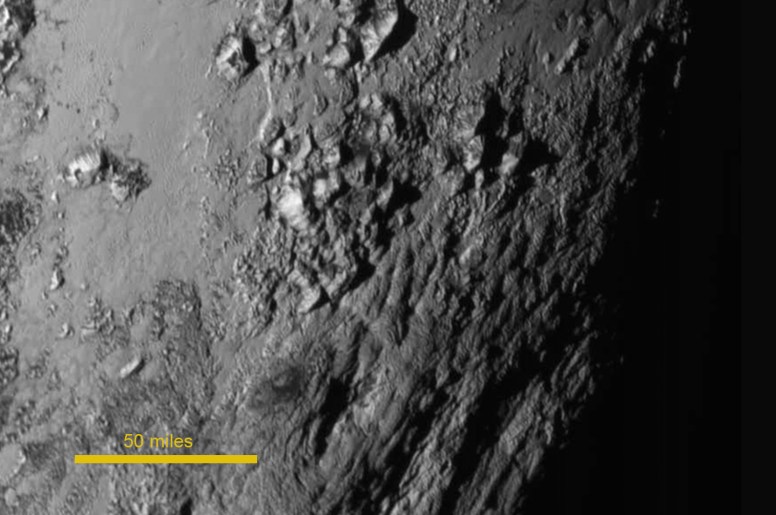Can Nature Perform the Same Miracle MultipleTimes? Problems with Convergent Evolution
While I was studying chemistry in graduate school at the University of Texas, I befriended a physics graduate student, who was studying echolocation in bats in the hopes that the research might result in helpful technologies for blind people. One day he invited me to his lab to watch as he fed the bats. We entered a small room where dozens of bats eagerly waited for a dinner of yellow grub worms. Many of the bats were hanging from the ceiling but others were flying around us yet never touching us. I looked at one bat on the ceiling as he looked down at us. His mouth was open and his lips quivered as he rapidly rotated his head round and round. I was fascinated. The bat was using his echolocation capability, akin to sonar, to map out the environment.
Pluto and New Horizons in review
The following article is reprinted with the author’s permission posted by Terry A. Hurlbut on November 4, 2016 at the Creation Science Hall of Fame, http://creationsciencehalloffame.org/2016/11/04/astronomy-2/space/pluto-new-horizons-review/. The reader is directed to the Creation Science Hall of Fame web site for additional videos related to this article.
On 27 October 2016, controllers for the New Horizons deep-space mission achieved a milestone. They got back the last data from their spacecraft’s flyby of the dwarf planet Pluto. Alice Bowman, head of the mission team, said the team would first verify the data. They then will order New Horizons to erase its memories. New Horizons must do this ahead of a planned rendezvous with another Kuiper Belt object (2014 MU69). It will make this flyby on or about 1 January 2019).
New Horizons flew past Pluto on 15 July 2015. Now NASA and the Johns Hopkins University Applied Physics Laboratory (JHUAPL) have all the data it gathered in that passage. So now would be a good time to review what New Horizons found, and what it means. In fact, the Pluto findings mean a great deal, not only for Pluto, but also for Earth.
What New Horizons found in the Pluto system
New Horizons flew toward a body everyone thought was 4.6 billion years old, like the rest of the solar system. So the mission team expected to find signs of great age. Instead they found signs, not of age, but of youth. They also found or confirmed several things they still cannot explain.
One of the first articles from JHUAPL discussed the first shocking findings:
- Equatorial mountains on Pluto, made of water ice, rise 3500 meters (11,000 feet) above the surface.
- Charon, largest moon of Pluto, has cliffs, troughs, and a seven- to nine-mile deep canyon.
- Methane ice abounds on Pluto, in some places far more than others.

Fig.1:, showing mountains rising to 3500 feet above mean ground, and standing out in stark relief. Source: NASA/JHUAPL/SwRI
The Amazing Ear: Evidence for Design

Figure 1 - “Tidens naturlære fig40” by Morten Bisgaard. From the book Tidens naturlære 1903 by Poul la Cour. By Morten Bisgaard [Public domain], via Wikimedia Commons, Licensed under Public Domain via Wikimedia Commons. "https://commons.wikimedia.org/wiki/File:Tidens_naturl%C3%A6re_fig40.png"
Calling All Creationists in the Triangle: TASC’s Mission and Future
The creation/evolution debate is a critical battle ground for the hearts and minds of everyone. What we think about our origins impacts everything we think about the world and ourselves. If human beings are merely the result of natural law working over billions of years as materialists claim, then any action we “choose” can be justified since we become the arbiters of right and wrong. Our culture is becoming increasingly secular in its thinking and policies. Moral relativism, situation ethics, sexual permissiveness in all its forms, abortion, theft, senseless mass murders, tolerance and even justification for dishonesty, are on the rise. We are at a critical time, a tipping point, in the history of our nation.

![Fig. 1 - M2-9 - Does this illustrate forces described in the article? The Twin Jet Nebula ESA/Hubble [CC BY 3.0 (http://creativecommons.org/licenses/by/3.0)], via Wikimedia Commons](https://upload.wikimedia.org/wikipedia/commons/thumb/e/e6/The_Twin_Jet_Nebula.jpg/512px-The_Twin_Jet_Nebula.jpg)